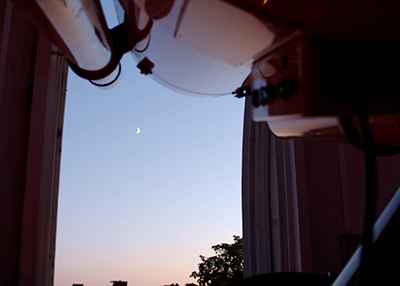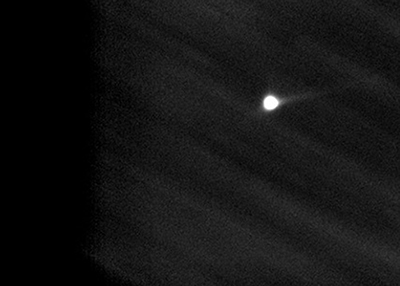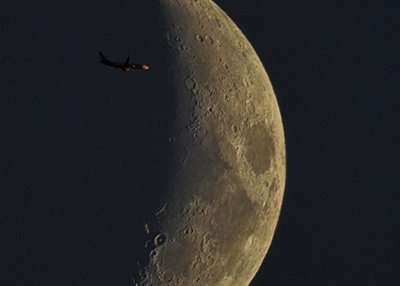MSU helps confirm success of NASA’s first planetary defense mission, trains future astronomers
It’s not hard to make the case that Seth Jacobson is a bit of a celebrity scientist: Leonardo DiCaprio kind of played him.
In the movie “Don’t Look Up,” DiCaprio portrayed a fictitious Michigan State University scientist trying to save the world from a comet on a collision course with Earth. Jacobson is a real MSU scientist working with NASA to prove it could redirect incoming space rocks if the need arises.
In fact, Jacobson recently contributed to a paper published in the journal Nature that’s part of the first wave of analysis showing how NASA successfully knocked a near-Earth asteroid off its initial path (to be clear, this was a proof-of-concept mission and the planet wasn’t in immediate danger).
Despite his success and arguable celebrity status, though, Jacobson isn’t interested in the spotlight. Instead, he said, that belongs to up-and-coming astronomers whose names aren’t listed on this particular paper.

A view of the moon through the open dome of the MSU Observatory. Caption/alt text: A view of the moon through the open dome of the MSU Observatory. Credit: Michael D-L Jordan/DLP
“The best part of this story is the astronomy students at the MSU Observatory,” said Jacobson, an assistant professor in the Department of Earth and Environmental Sciences in the MSU College of Natural Science. “The undergrads are driving research at the observatory. They’re out there observing all night. They finish their classes, have dinner, stay up until 5 o’clock in the morning at the observatory and still make their classes the next day.”
The MSU Observatory has a decades-long history of enabling undergraduates to get valuable hands-on research experience, but that was put on hold during the coronavirus pandemic. Now, the MSU Observatory Research Program, or MORP, is back.
Although MORP’s data wasn’t included in the first round of publications detailing the asteroid deflection, the team already has new papers in the works, Jacobson said. And these papers are really a byproduct, rather than the end goal, of MORP’s mission.
The MSU Observatory is enabling undergraduates to generate important data for the astronomy community while gaining valuable skills and experience in an increasingly competitive field. In doing so, they’re setting themselves and future generations of Spartan students up for success.
Astronomical redirections
Emma Dugan is a senior in the Department of Physics and Astronomy who works astronomist Joey Rodriguez, an assistant professor in the department who also oversees undergraduate research at the observatory. On Rodriguez’s team, Dugan typically studies exoplanets — worlds beyond our solar system.

Michigan State University senior Emma Dugan, who is part of the MSU Observatory Research Program. Credit: Michael D-L Jordan/DLP
This past fall, though, she was looking for a new topic for her senior thesis project. One evening, she attended a local, informal astronomy event where Jacobson was presenting one of his projects. It was NASA’s first planetary defense mission called the Double Asteroid Redirection Test, or DART.
The DART mission was happening at the perfect time,” Dugan said. “After I heard Seth’s talk, we realized the observatory would be capable of seeing the asteroid. From there, we wanted to find out if we could get any useful data.”
The premise behind DART is straightforward: If an asteroid is hurtling toward our planet, we may be able to deflect it safely away by hitting it with a low-cost, uncrewed spacecraft.
To test that theory, NASA sent the DART Impactor spacecraft barreling into an asteroid named Dimorphos at 13,000 miles per hour. (Dimorphos orbits a larger asteroid named Didymos, hence the “Double Asteroid” part of DART).

An image of the asteroid system struck by NASA’s Double Asteroid Redirection Test, or DART, mission captured by Michigan State University undergraduate students at the MSU Observatory on Oct. 3, 2022. The faint trail visible to the right of the bright spot is material ejected from the collision, which took place on Sept. 26. Credit: Michael Bellaver and Jeremy Fedewa/MSU Observatory Research Program
The collision was roughly seven million miles away from Earth, which is close enough to see with telescopes like the one at the MSU Observatory. That’s important because astronomers had to keep tabs on Dimorphos for weeks after the impact to learn if and how much DART had altered its course.
Although NASA has fancy space telescopes that could do that, DART was designed to work with support from a global network of ground-based observatories like MSU’s for a simple reason: cost.
“The James Webb Space Telescope and Hubble both looked at the asteroid before and after impact, but it’s really expensive to do that,” Dugan said. At MSU, Dugan and her MORP colleagues could watch the asteroid every clear night for a month for next to nothing in comparison.
MORP’s data wasn’t included in the recent Nature publication — there was an abundance of high-quality data from other sources — but that doesn’t mean it was useless or that the observations were a waste of time.
For starters, that data will be part of a new paper the team is already working on. Furthermore, this work added near-Earth asteroids to the list of celestial objects undergrads can research at the observatory.

An airplane makes a cameo in this image of the moon taken with the MSU Observatory’s 24-inch telescope. Credit: Elias Aydi
“It was really hard to know what to expect going into this,” Dugan said. “It wasn’t like anything we had observed before.”
Tracking an asteroid that was basically our neighbor required a different approach than observing distant exoplanets, which she had studied on Rodriguez’s team prior to her thesis project.
But Dugan wasn’t alone. She had help from the MORP cohort, currently about 15 undergraduates, and former postdoctoral researcher Kirill Sokolovsky who is now with the University of Illinois Urbana-Champaign. Their effort produced new techniques that can be adopted and adapted by future MORPers.
Rodriguez anticipates MORP’s membership will grow by about 60% this summer, even accounting for its graduating members. That includes Dugan, who’s currently deciding which of two graduate school offers to accept.
“The observatory completely changed the track I was on,” Dugan said. “In a very good way.”Banner image: Members of the MSU Observatory Research Program wave from inside the observatory, beneath a 24-inch telescope. Credit: Elias Aydi